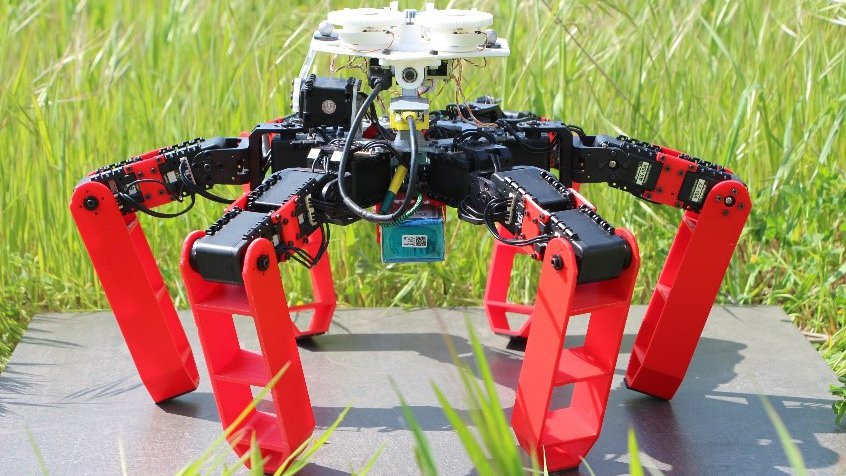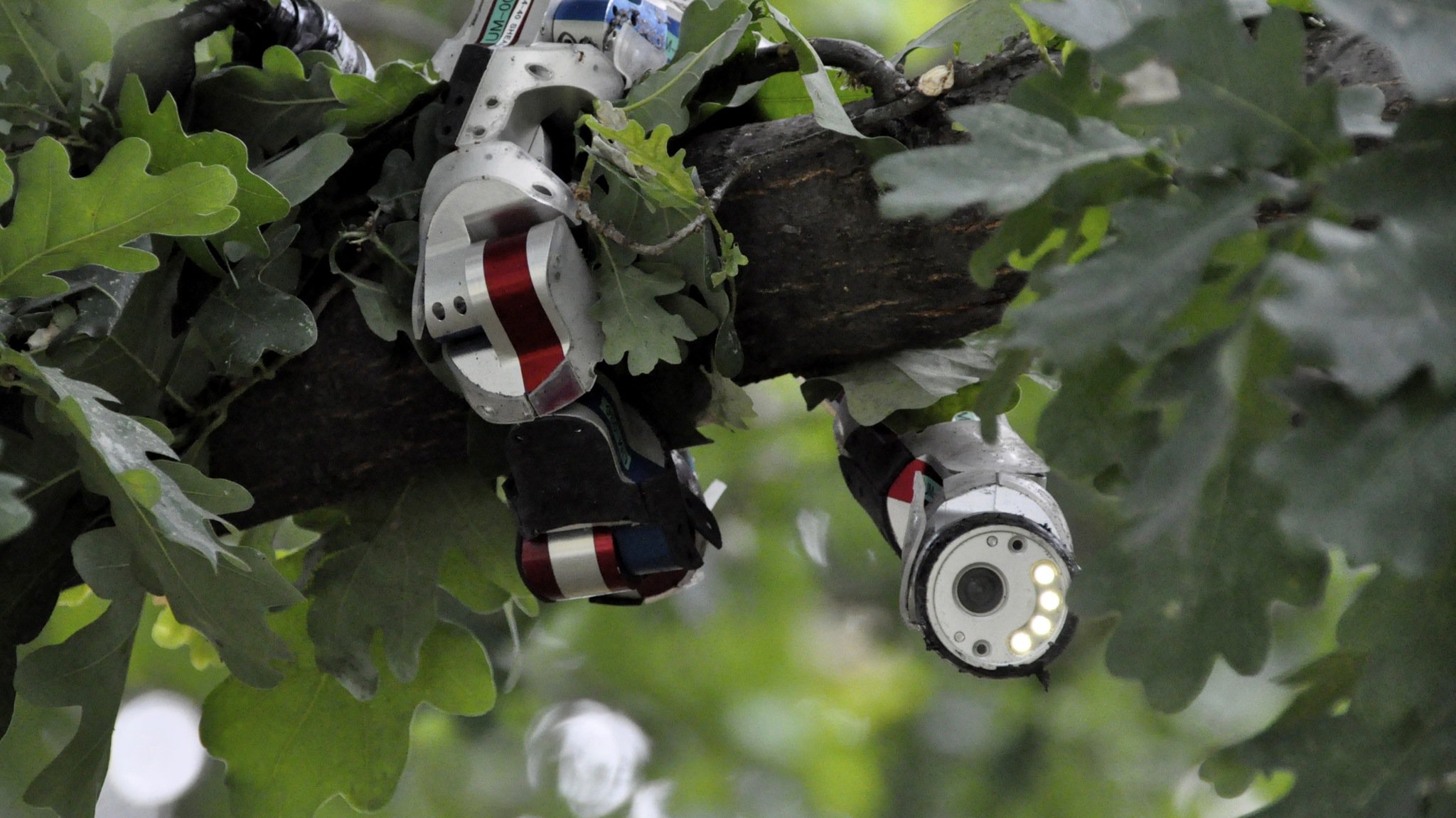Forget GPS—This Robot Navigates Like an Ant
The six-legged AntBot uses clues from the sun to scuttle straight home on the most efficient path.

The six-legged AntBot is a walking robot that navigates by borrowing some tricks from desert ants. It can count its steps, track objects moving through its field of view, and read polarized patterns of light in the sky. Image Credit: Julien Dupeyroux, Aix-Marseille University
Compared to other animals, humans are pretty terrible navigators. We’re blind to ultraviolet light, and have no real read on the magnetic field; spin us around a few times and we’ll get discombobulated enough to stumble face-first into the nearest wall.
All this goes to say, we’re very much shackled to devices that can do this dirty work for us. Which makes it that much tougher when these systems fail due to inaccurate pinpointing or a faulty signal.
But today, in the journal Science Robotics, a team of French scientists unveils new technology that just might bolster our future travels: AntBot, an insect-inspired walking robot that models its navigational capabilities on those of—you guessed it—ants.
Thrust out into the cold, unforgiving world, AntBot is able to scuttle homeward by capitalizing on three crucial pieces of intel: its location relative to the pattern of polarized light in the sky, the movement of the ground through its field of view, and the number of steps it’s taken. Though the technology is still in its early stages, AntBot already navigates with a high rate of success, even in various weather conditions that might befuddle some traditional positioning systems.
“This is remarkable,” says Viktor Gruev, an engineer who studies bio-inspired systems at the University of Illinois at Urbana-Champaign, but was not involved in the study. “This paper shows an excellent way of taking desert ants’ different senses… and integrating them into a very elegant solution to recreate navigational capabilities.”
Human-made navigation systems have done wonders for the modern world, but they still have some serious deficits. GPS, for instance, has poor resolution at small distances, and is often stymied in the presence of tall buildings or big geological landmarks, like canyons.
But despite their lack of access to cutting-edge technology, animals like desert ants have had the whole navigation thing figured out for millennia. Even when separated from their nests by hundreds of meters—thousands of times the lengths of their own bodies—these intrepid insects can make a beeline (or antline) home via the fastest possible route.

Cataglyphis bicolor, the Sahara Desert ant, navigates through the hot sands by using cues from the sun and counting its own steps. Image Credit: Jeff Kingma, iStock
The key, it seems, is the ants’ ability to tune in to three cues. First, they count their own steps (sans Fitbit, of course). Second, they track how objects in their environment, like the ground beneath their feet, whiz through their field of view. And third, they take note of the angle of their path with respect to the polarization pattern of ultraviolet light in the sky, which scatters out reliably depending on the position of the Sun. By blending these three sources of information together, the ants can essentially gauge where they are and how fast they’re moving.
“The task of navigation is complicated, but animals have all these clever strategies,” says study author Stéphane Viollet, a bioroboticist at Aix-Marseille University in France. “You need only three pieces of information... It’s very simple in the end.”
Scientists have known about these strategies for years, and AntBot is just one of many biology-inspired robots to tackle the challenge of navigation. But the new six-legged robot, designed and constructed by a team led by Viollet, is the first to suit up with two optical sensors that, together, help nail this particular trifecta of ant exploration.
To test AntBot’s navigational prowess, the team sent it roaming in sunny Marseille, France. Treading like a cautious six-legged spider, AntBot explored a small area, measuring about 10 feet by 13 feet, in meandering zigzags, mimicking the movements of a foraging desert ant. Once it had satisfied its wanderlust, the robot set its gaze homeward—and the true test began. When the team monitored AntBot’s ability to zero in on the fastest path back to its starting point, with minimal deviations, the robot sailed through with only the occasional inch or two of error. Because its optical sensors could see in ultraviolet, AntBot even had success when the skies clouded over, blocking portions of visible sunlight.
“Insects are marvels of engineering,” says Barani Raman, a bioengineer at Washington University in St. Louis who was not involved in the study. “This shows that... we should have more robotics based on insect-inspired solutions.”
AntBot is still in development, but the team is already collaborating with car companies to incorporate these navigation techniques into existing systems. Eventually, the hope is that these tools will complement the deficits of GPS and other methods, and even help steer autonomous vehicles.
And AntBot itself could eventually be put to work. Clocking in at just five pounds total, the robot traipses across terrain like a sturdy, six-legged spider. AntBot’s wheel-free design means it might do well on rough or rugged surfaces—places that other robots or humans are unable to access. That could really come in handy in the wake of natural disasters, says Xinyan Deng, a mechanical engineer and roboticist at Purdue University who was not involved in the study.
Before any of that happens, though, there are a few kinks to work out. At the moment, AntBot isn’t sensitive enough to low levels of light to be functional when the sun sets (desert ants, too, are less active at night). And AntBot isn’t yet equipped with collision avoidance technology—something that’ll need to be addressed before it gets anywhere near a self-driving car.
What’s more, the robot’s maximum range of travel is still only a few dozen feet; for AntBot to measure up to the navigational superpowers of its namesake, it would need to successfully traverse a few hundred miles—close to the distance between New York City and Washington, D.C., says study author Julien Dupeyroux of Aix-Marseille University. In other words, AntBot still has a ways to go.
In the meantime, Deng says she’s already impressed with the robot’s capabilities. And while the technology was initially motivated by a biological phenomenon, Deng is enthusiastic about the possibility of this relationship becoming bidirectional. “There could be dual objectives,” she says. “The robot has a new sensing design, but on the other hand, it could provide biologists with a platform to decode how locomotion works in ants.”
And ultimately, this goes to show just how powerful biological solutions can be, Deng says. Despite only having a few thousand neurons in their brains (compared to the billions in ours), desert ants work navigational wonders that humans have yet to fully achieve.
“A lot of robotics applications rely on a lot of complicated sensors and machine learning,” Gruev says. “But we can take inspiration from these little ants and see how they accomplish simple navigational tasks with limited computational ability. You don’t need sophistication and complexity if you take a step back and think outside the box.”


